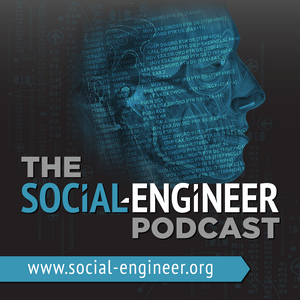Ep. 299 - The Doctor Is In Series - Why Do We Cry?
Welcome to the Social-Engineer Podcast: The Doctor Is In Series – where we will discuss understandings and developments in the field of psychology. In today’s episode, Chris and Abbie are discussing Why Do We Cry? They will talk about the psychological and biological influence on our crying, as well as those that cry too much, too little, and how to get support to find the right balance. [April 7, 2025] 00:00 - Intro 00:16 - Dr. Abbie Maroño Intro 00:31 - Intro Links - Social-Engineer.com - http://www.social-engineer.com/ - Managed Voice Phishing - https://www.social-engineer.com/services/vishing-service/ - Managed Email Phishing - https://www.social-engineer.com/services/se-phishing-service/ - Adversarial Simulations - https://www.social-engineer.com/services/social-engineering-penetration-test/ - Social-Engineer channel on SLACK - https://social-engineering-hq.slack.com/ssb - CLUTCH - http://www.pro-rock.com/ - innocentlivesfoundation.org - http://www.innocentlivesfoundation.org/ 02:55 - The Topic of the Day: Why do we cry? 03:23 - An Emotional Release 04:50 - Biologically Speaking 06:15 - Crying Too Much? 10:14 - Chemical Reaction 12:12 - Let It Out! 15:25 - Suppression Depression 18:38 - Symptom, Not Cause 20:32 - The Hormone Effect 21:22 - Best Next Steps 23:53 - Wrap Up 24:23 - Next Month: Emotional Regulation in the Workplace 25:25 - Outro - www.social-engineer.com - www.innocentlivesfoundation.org Find us online: - Twitter: @DrAbbieofficial - LinkedIn: linkedin.com/in/dr-abbie-maroño-phd - Instagram: @DoctorAbbieofficial - Twitter: @humanhacker - LinkedIn: linkedin.com/in/christopherhadnagy References: Bagby, D. G. (1999). Seeing through our tears: Why we cry, how we heal. Augsburg Books. Bylsma, L. M., Gračanin, A., & Vingerhoets, A. J. (2019). The neurobiology of human crying. Clinical Autonomic Research, 29, 63-73. Feeny, N. C., Zoellner, L. A., Fitzgibbons, L. A., & Foa, E. B. (2000). Exploring the roles of emotional numbing, depression, and dissociation in PTSD. Journal of traumatic stress, 13, 489-498. Gračanin, A., Bylsma, L. M., & Vingerhoets, A. J. (2014). Is crying a self-soothing behavior?. Frontiers in psychology, 5, 82046. Holguín-Lew, J. C., & Bell, V. (2013). “When I Want to Cry I Can’t”: Inability to Cry Following SSRI Treatment. Revista Colombiana de Psiquiatría, 42(4), 304-310. Lilley, M. (2019). Why We Cry: The Science of Tears. Compass Point Books. Millings, A., Hepper, E. G., Hart, C. M., Swift, L., & Rowe, A. C. (2016). Holding back the tears: Individual differences in adult crying proneness reflect attachment orientation and attitudes to crying. Frontiers in psychology, 7, 196642. Ramirez, S. M., Glover, H., Ohlde, C., Mercer, R., Hamlin, C., Goodnick, P., & Perez-Rivera, M. I. (2001). Relationship of numbing to alexithymia, apathy, and depression. Psychological Reports, 88(1), 189-200. Steer, R. (2011). Self-reported inability to cry as a symptom of anhedonic depression in outpatients with a major depressive disorder. Psychological reports, 108(3), 874-882. Trimble, M. (2014). Why humans like to cry: Tragedy, evolution, and the brain. Oxford University Press. Vingerhoets, A. J., & Bylsma, L. M. (2016). The riddle of human emotional crying: A challenge for emotion researchers. Emotion Review, 8(3), 207-217. Vingerhoets, A. J., & Scheirs, J. G. (2012). Crying and health. In Adult crying (pp. 227-246). Routledge. Vingerhoets, A. J., Cornelius, R. R., Van Heck, G. L., & Becht, M. C. (2000). Adult crying: A model and review of the literature. Review of General Psychology, 4(4), 354-377. Walter, C. (2006). Why do we cry?. Scientific American Mind, 17(6), 44-51.
